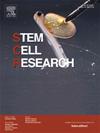Generation of a genetically encoded voltage indicator MARINA reporter human iPS cell line using Cas9 (VULSCi002-A-2)
IF 0.8
4区 医学
Q4 BIOTECHNOLOGY & APPLIED MICROBIOLOGY
引用次数: 0
Abstract
Fluorescent protein-based Genetically Encoded Voltage Indicators (GEVI) offer a remarkable system for high-throughput screening of membrane potential phenotypes. The GEVI MARINA is a derivative from ArcLight, which conversely to ArcLight increases its fluorescence intensity alongside depolarization. Here we created knock-in reporter human iPS cell lines carrying the MARINA reporter using SpCas9 programmable nuclease and characterize a heterozygous clone.
使用Cas9 (VULSCi002-A-2)生成遗传编码电压指示器MARINA报告细胞。
基于荧光蛋白的基因编码电压指示器(GEVI)为高通量筛选膜电位表型提供了一个卓越的系统。GEVI MARINA 是 ArcLight 的衍生物,与 ArcLight 相反,它的荧光强度会随着去极化而增加。在这里,我们利用 SpCas9 可编程核酸酶创建了携带 MARINA 报告器的敲入报告人类 iPS 细胞系,并鉴定了一个杂合克隆。
本文章由计算机程序翻译,如有差异,请以英文原文为准。
求助全文
约1分钟内获得全文
求助全文
来源期刊

Stem cell research
生物-生物工程与应用微生物
CiteScore
2.20
自引率
8.30%
发文量
338
审稿时长
55 days
期刊介绍:
Stem Cell Research is dedicated to publishing high-quality manuscripts focusing on the biology and applications of stem cell research. Submissions to Stem Cell Research, may cover all aspects of stem cells, including embryonic stem cells, tissue-specific stem cells, cancer stem cells, developmental studies, stem cell genomes, and translational research. Stem Cell Research publishes 6 issues a year.
 求助内容:
求助内容: 应助结果提醒方式:
应助结果提醒方式:


